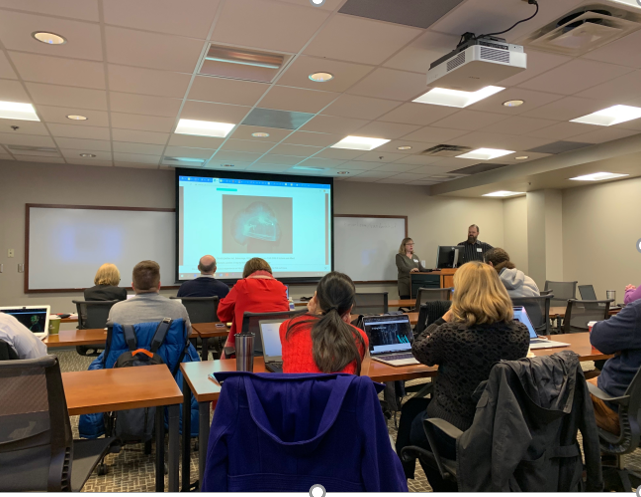International Image Interoperability Framework Workshop
By Meghan K. McGinley, 2019–2020 Hastac Scholar
 In December of 2019, the Digital Cultural Heritage Cluster of the Center for Digital Humanities welcomed Ben and Sara Brumfield of Brumfield Labs to Vanderbilt University to hold a day-long workshop on the International Image Interoperability Framework (IIIF). Preserving cultural heritage through digital means, IIIF creates overarching metadata standards for high-resolution images, including moving and 3-D representations. The deep zoom and tiling functionality that IIIF provides allows users to reference and examine various portions of an object—producing a multitude of images from a single source. While IIIF offers invaluable consistency for data formatting across institutional landscapes, it is the potential for scholarly collaboration that makes the implementation of this emerging standard so appealing to Digital Humanists.
In December of 2019, the Digital Cultural Heritage Cluster of the Center for Digital Humanities welcomed Ben and Sara Brumfield of Brumfield Labs to Vanderbilt University to hold a day-long workshop on the International Image Interoperability Framework (IIIF). Preserving cultural heritage through digital means, IIIF creates overarching metadata standards for high-resolution images, including moving and 3-D representations. The deep zoom and tiling functionality that IIIF provides allows users to reference and examine various portions of an object—producing a multitude of images from a single source. While IIIF offers invaluable consistency for data formatting across institutional landscapes, it is the potential for scholarly collaboration that makes the implementation of this emerging standard so appealing to Digital Humanists.
The Brumfield Labs led workshop used a multitude of hands-on exercises and case studies to demonstrate the tool’s capacity. With these exercises, participants explored various aspects of the first three of IIIFs four Application Programming Interfaces (APIs): Image, Presentation, Authentication, and Search. One exercise, pulled from the website Image API Playground, allowed participates to “hack” the URL of an API enabled image. Playing with the parameters, whether they be the region, size, or rotation, a user can draw attention to certain aspects of an image without any loss in resolution. Image viewers, such as Mirador, also allow for individual annotations of visual objects and side-by-side windows for image comparison. Presentation API allows for users to assemble IIIF enabled images and create public-facing projects by way of a manifest, which contains the underlying structure and proprieties of the all images in a compilation. If certain objects and/or images in a IIIF enabled digital collection need to be designed for private use, an Authentication API, which serves as a login checkpoint, can prove useful. Lastly, if images, such as manuscripts, have Optical Character Recognition (OCR) enabled text, a Search API helps to facilitate keyword searches. As the Brumfields emphasized in their workshop, an organization can pick and choose the APIs that best suit their needs—each one of them bringing their own distinctive benefits in IIIF implementation.

Ben and Sara Brumfield (pictured far right) demonstrating the IIIF enabled X-raying Balenciaga project.
Employing IIIF also promotes cross-institutional scholarly collaboration. For example, The Digital Cicognara Library project uses IIIF enabled images hosted by a wide range of institutions across the globe, including but not limited to The Vatican Apostolic Library, The National Gallery of Art, and Princeton University, to digitally recreate the personal library of Italian Count Leopoldo Cicognara (1767-1834). Due to an increasing amount of institutions adopting the IIIF standard, the curation of new public-facing digital scholarship with difficult to access, fragile, or fragmented materials is becoming a reality. At Vanderbilt University, The Slaves Societies Digital Archive, will be enabling more than 700,000 digital images with the IIIF protocol in order to continue preservation efforts and facilitate future cross-institutional scholarship of many at-risk documents that chronicle the “history of Africans and their descendants in the Atlantic World” (slavesocieties.org).